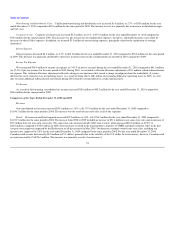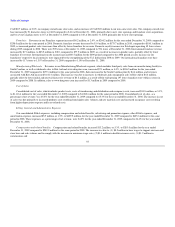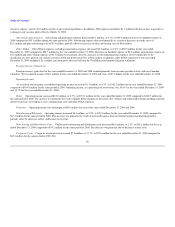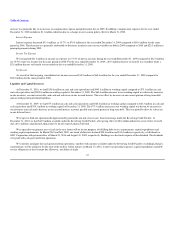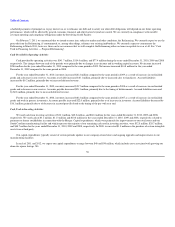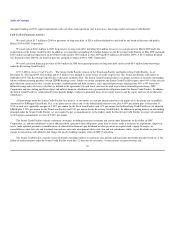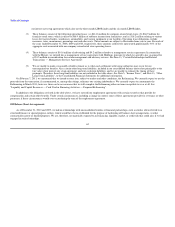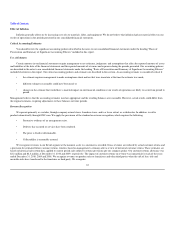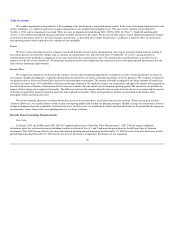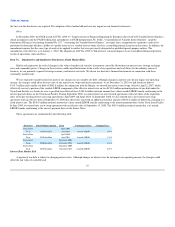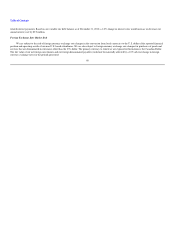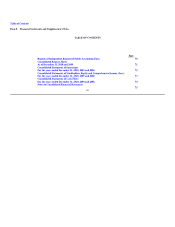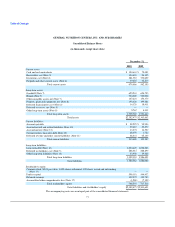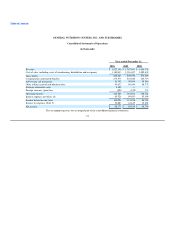GNC 2011 Annual Report Download - page 68
Download and view the complete annual report
Please find page 68 of the 2011 GNC annual report below. You can navigate through the pages in the report by either clicking on the pages listed below, or by using the keyword search tool below to find specific information within the annual report.
Table of Contents
revenues from franchise fees at the time a franchise store opens or at the time of franchise renewal or transfer, as applicable.
Inventories
Where necessary, we adjust the carrying value of our inventory to the lower of cost or net realizable value. These estimates require us to make
approximations about the future demand for our products in order to categorize the status of such inventory items as slow moving, obsolete, or in excess of
need. These future estimates are subject to the ongoing accuracy of management's forecasts of market conditions, industry trends, and competition. While we
make estimates of future demand based on historical experience, current expectations and assumptions that we believe are reasonable, if actual demand or
market conditions differ from these expectations and assumptions, actual results could differ from our estimates. We are also subject to volatile changes in
specific product demand as a result of unfavorable publicity, government regulation, and rapid changes in demand for new and improved products or services.
Our inventory reduction for obsolescence and shrinkage was $11.0 million and $9.6 million at December 31, 2010 and 2009, respectively. This represented
2.8% and 2.5% of our gross inventory value at each period, respectively. The change from period to period is primarily the result of inventory fluctuations and
management of inventory movement throughout our system. The impact on cost of goods sold as a result of these allowances was immaterial for each of the
years ended December 31, 2010, 2009 and 2008.
Accounts Receivable and Allowance for Doubtful Accounts
The majority of our retail revenues are received as cash or cash equivalents. The majority of our franchise revenues are billed to the franchisees with
varying terms for payment. We offer financing to qualified domestic franchisees with the initial purchase of a franchise location. The notes are demand notes,
payable monthly over periods of five to seven years. We generate a significant portion of our revenue from ongoing product sales to franchisees and third-
party customers. An allowance for doubtful accounts is established based on regular evaluations of our franchisees' and third-party customers' financial health,
the current status of trade receivables, and any historical write-off experience. We maintain both specific and general reserves for doubtful accounts. General
reserves are based upon our historical bad debt experience, overall review of our aging of accounts receivable balances, general economic conditions of our
industry, or the geographical regions and regulatory environments of our third-party customers and franchisees. Management's estimates of the franchisees'
financial health include forecasts of the customers' and franchisees' future operating results and the collectability of receivables from them. While we believe
that our business operations and communication with customers and franchisees allows us to make reasonable estimates of their financial health, actual results
could differ from those predicted by management, and actual bad debt expense could differ from forecasted results. Our allowance for doubtful accounts was
$1.6 million and $1.8 million at December 31, 2010 and 2009, respectively. Changes in the allowance from period to period are primarily a result of the
composition of customers and their financial health. Bad debt expense was immaterial for each of the years ended December 31, 2010, 2009 and 2008.
Impairment of Long-Lived Assets
Long-lived assets, including fixed assets and intangible assets with finite useful lives, are evaluated periodically by us for impairment whenever events
or changes in circumstances indicate that the carrying amount of any such asset may not be recoverable. If the sum of the undiscounted future cash flows is
less than the carrying value, we recognize an impairment loss, measured as the amount by which the carrying value exceeds the fair value of the asset. These
estimates of cash flow require significant management judgment and certain assumptions about future volume,
64


